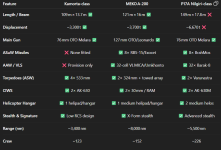Corvettes of Indian Navy : News and Discussions
- Thread starter Ashwin
- Start date
-
- Tags
- kamorta class project 28
You are using an out of date browser. It may not display this or other websites correctly.
You should upgrade or use an alternative browser.
You should upgrade or use an alternative browser.
Attachments
Last edited:
India Commissions Its First ASW-SWC Corvette
Published on 25/06/2025
By Dimitris Mitsopoulos

Infographic of INS Arnala ASW-SWC by the author for Naval News.
On June 18, 2025, the Indian Navy commissioned the first of 16 Anti-Submarine Warfare Shallow Water Craft (ASW-SWC), essentially a light corvette, to enhance the protection of its vast coastline against subsurface threats such as submarines, midget submarines and unmanned underwater vehicles (UUVs).
INS Arnala, the first of 16 indigenously designed and built Anti-Submarine Warfare Shallow Watercraft (ASW-SWC), which is essentially a corvette, was commissioned into the Eastern Naval Command of the Indian Navy on 18 June 2025. The commissioning ceremony took place at the Naval Dockyard in Visakhapatnam, in the presence of General Anil Chauhan, Chief of Defence Staff.
Among the others present were Vice Admiral Rajesh Pendharkar, Flag Officer Commanding-in-Chief, Eastern Naval Command, Vice Admiral Rajaram Swaminathan, CWP&A, Cmde P R Hari, IN (Retd), Chairman and Managing Director, GRSE, ADG Donny Michael, Coast Guard Commander (Eastern Seaboard), senior officials from Indian Navy and Garden Reach Shipbuilders & Engineers (GRSE) and Larsen & Toubro Shipbuilding (L&T), distinguished civilian dignitaries, ex- Commanding Officers of erstwhile Arnala and guests.
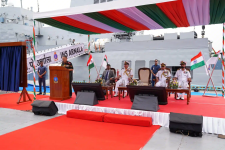
Commissioning ceremony of INS Arnala into the Indian Navy fleet. Photo courtesy of the Indian Navy.
The ASW-SWC program began in June 2014, when the Ministry of Defence (MoD) issued a tender to private shipyards for the procurement of 16 specialized vessels to safeguard India’s vast coastline. Following a competitive evaluation process, Cochin Shipyard Limited (CSL) and Garden Reach Shipbuilders & Engineers (GRSE) emerged as the lowest and second-lowest bidders, respectively, in October 2017. In April 2019, both GRSE and Cochin Shipyard Limited (CSL) had signed contracts to build eight ASW SWC ships each.
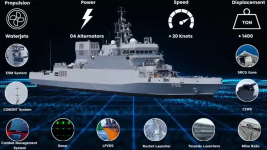
Indian Navy infographic detailing INS Arnala’s weapons, electronic systems, and technical specifications.
The Indian ASW-SWC was designed and constructed under a Public-Private Partnership (PPP) model—the first of its kind in India—where a major public sector undertaking (PSU) shipyard, GRSE, collaborated with the capable private shipyard L&T Kattupalli. This innovative approach marked a significant milestone in India’s shipbuilding ecosystem. INS Arnala was launched on December 2022 while it holds particular distinction, as it earned GRSE the Raksha Mantri’s Award the same year for designing the ‘most silent ship’. Two years later, in October 2024, the ship started its sea trials. GRSE is currently constructing seven additional ASW-SWC vessels for the Indian Navy.

The design by CSL, the Mahe class, is different than the one of GRSE. Image by CSL.
Simultaneously, CSL is building eight vessels under the same program but of a different design, the Mahe class. Deliveries of CSL’s ships are scheduled between August 2025 and June 2028. Once inducted, INS Arnala and the remaining 15 vessels will replace the ageing Abhay-class corvettes (customised variants of the Russian Pauk-class corvettes), commissioned between 1989 and 1991, significantly enhancing the Indian Navy’s coastal defense and anti-submarine capabilities.
The warship features 80% indigenous content, integrating advanced systems from major Indian defence firms along with components from smaller enterprises. This approach ensures that large-scale defence production is carried out by domestic manufacturers, fostering employment, enhancing national capabilities, and strengthening self-reliance in shipbuilding and defence technology.
Technical Specifications

Rear view of INS Arnala with the openinings at the stern for mine rails and minelaying. Note the two torpedo decoy launchers and one of the two triple torpedo launchers
Named after the historic coastal fort off Maharashtra, the induction of the new Indian ASW-SWC marks a significant step forward in strengthening India’s naval capabilities in line with the envisioned force levels to meet emerging maritime challenges. INS Arnala is equipped with an advanced suite of anti-submarine warfare (ASW) weapons and sensors and is designed for a wide range of ASW operations. This extremely agile vessel is capable of conducting sub-surface surveillance and interdiction, minelaying, search and rescue (SAR) missions, low-intensity maritime operations (LIMO) in littoral and coastal waters and coordinated ASW operations with naval aircraft.
The ship will be capable of detecting and engaging submarines, including midget submarines, as well as unmanned underwater vehicles (UUVs) in coastal waters, thanks to its enhanced maneuverability and shallow draught of just 2.7 meters. This allows it to operate effectively in littoral zones that are inaccessible to larger warships. It also incorporates stealth technology to reduce its radar cross-section (RCS), along with a low acoustic and infrared (IR) signature.
Measuring 77.6 meters in length and 10.5-metre-wide and displacing at full load about 1,500 tonnes, INS Arnala is the largest Indian Navy warship till today to be powered by a diesel engine–waterjet propulsion system (three water jets). Νote that the first water jet-propelled vessels of the Indian Navy were the 14 (now 13) 49-meter Car Nicobar-class patrol vessels which were commissioned between 2009 and 2017. The ships have a maximum speed of 25 knots, a maximum range of over 1,800nm and has a complement of 57 personnel, including seven officers. It carries at least one RHIB.
Weapon Systems
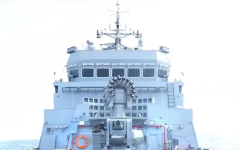
The rocket launcher and the gun forward of the bridge at the bow of the Indian corvette. Image by Indian Navy.
The new ship tailored for operations in littoral and shallow waters. Its robust and modern weapons configuration ensures mission effectiveness in its primary ASW role, while retaining the versatility required for a wide range of maritime operations. Additionally, the ship is equipped with dedicated mine-laying rails for deploying anti-submarine mines, providing area denial capability and reinforcing underwater threat deterrence.
Its main ASW armament includes a forward-mounted 12-tube RBU-6000 anti-submarine rocket launcher—an effective system for engaging close-range sub-surface threats. At the aft section, two triple trainable 324mm torpedo launchers house the indigenous Advanced Light Weight Torpedo (ALWT), designed for precision strikes against enemy submarines. Positioned behind these are two sextuple torpedo decoy launching systems (DLS) from Mahindra, enhancing survivability against incoming torpedoes.

One of the two triple 324mm torpedo launchers of INS Arnala. Image by Indian Navy.
The ship’s protection is provided by a combination of advanced naval gun systems. Its primary armament is a 30mm Naval Surface Gun (NSG) mounted at the bow, which functions as both the main gun and a Close-In Weapon System (CIWS). This system is capable of engaging both surface and aerial threats with high effectiveness. Complementing the main gun are two 12.7mm Stabilized Remote Control Gun (SRCG) systems, positioned amidships, manufactured by Ordnance Factory Tiruchirappalli (OFT). These systems enhance close-range defense and offer high targeting accuracy in dynamic maritime environments.

NSG 30mm RWS on INS Arnala. GRSE image.
The 30mm NSG is an indigenously developed autocannon, designed by Garden Reach Shipbuilders & Engineers (GRSE) in collaboration with Blue Horizons Strategic Engineering Ltd. (BHSEL) and Elbit Systems. It is integrated with a fully indigenous Electro-Optical Fire Control System (EO-FCS) on the mast, significantly improving targeting precision. Notably, the NSG features 60% indigenous content and was developed within just two years. The system successfully completed Sea Acceptance Trials (SAT) aboard INS Arnala on 22 May 2025.
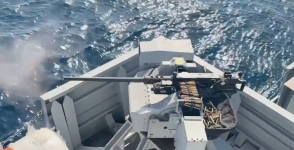
SRCG 12.7mm RWS. Indian Navy image.

6-barrel torpedo decoy launcher. Indian Navy image.
The SRCGs, known internationally as the Remote-Controlled Naval Weapon Station (RCNWS) in Elbit Systems’ portfolio, are produced by OFT under a transfer of technology agreement with Elbit Systems, Israel. Each lightweight, dual-axis 12.7mm station is designed specifically for marine applications and can remotely engage targets with high precision and with 450-600 rpm. The system includes a suite of modular optical sensors—day camera, thermal camera, and laser rangefinder—enabling target detection, automatic tracking, and engagement in both day and night operations.
continued....
Published on 25/06/2025
By Dimitris Mitsopoulos

Infographic of INS Arnala ASW-SWC by the author for Naval News.
On June 18, 2025, the Indian Navy commissioned the first of 16 Anti-Submarine Warfare Shallow Water Craft (ASW-SWC), essentially a light corvette, to enhance the protection of its vast coastline against subsurface threats such as submarines, midget submarines and unmanned underwater vehicles (UUVs).
INS Arnala, the first of 16 indigenously designed and built Anti-Submarine Warfare Shallow Watercraft (ASW-SWC), which is essentially a corvette, was commissioned into the Eastern Naval Command of the Indian Navy on 18 June 2025. The commissioning ceremony took place at the Naval Dockyard in Visakhapatnam, in the presence of General Anil Chauhan, Chief of Defence Staff.
Among the others present were Vice Admiral Rajesh Pendharkar, Flag Officer Commanding-in-Chief, Eastern Naval Command, Vice Admiral Rajaram Swaminathan, CWP&A, Cmde P R Hari, IN (Retd), Chairman and Managing Director, GRSE, ADG Donny Michael, Coast Guard Commander (Eastern Seaboard), senior officials from Indian Navy and Garden Reach Shipbuilders & Engineers (GRSE) and Larsen & Toubro Shipbuilding (L&T), distinguished civilian dignitaries, ex- Commanding Officers of erstwhile Arnala and guests.

Commissioning ceremony of INS Arnala into the Indian Navy fleet. Photo courtesy of the Indian Navy.
The ASW-SWC program began in June 2014, when the Ministry of Defence (MoD) issued a tender to private shipyards for the procurement of 16 specialized vessels to safeguard India’s vast coastline. Following a competitive evaluation process, Cochin Shipyard Limited (CSL) and Garden Reach Shipbuilders & Engineers (GRSE) emerged as the lowest and second-lowest bidders, respectively, in October 2017. In April 2019, both GRSE and Cochin Shipyard Limited (CSL) had signed contracts to build eight ASW SWC ships each.

Indian Navy infographic detailing INS Arnala’s weapons, electronic systems, and technical specifications.
The Indian ASW-SWC was designed and constructed under a Public-Private Partnership (PPP) model—the first of its kind in India—where a major public sector undertaking (PSU) shipyard, GRSE, collaborated with the capable private shipyard L&T Kattupalli. This innovative approach marked a significant milestone in India’s shipbuilding ecosystem. INS Arnala was launched on December 2022 while it holds particular distinction, as it earned GRSE the Raksha Mantri’s Award the same year for designing the ‘most silent ship’. Two years later, in October 2024, the ship started its sea trials. GRSE is currently constructing seven additional ASW-SWC vessels for the Indian Navy.

The design by CSL, the Mahe class, is different than the one of GRSE. Image by CSL.
Simultaneously, CSL is building eight vessels under the same program but of a different design, the Mahe class. Deliveries of CSL’s ships are scheduled between August 2025 and June 2028. Once inducted, INS Arnala and the remaining 15 vessels will replace the ageing Abhay-class corvettes (customised variants of the Russian Pauk-class corvettes), commissioned between 1989 and 1991, significantly enhancing the Indian Navy’s coastal defense and anti-submarine capabilities.
The warship features 80% indigenous content, integrating advanced systems from major Indian defence firms along with components from smaller enterprises. This approach ensures that large-scale defence production is carried out by domestic manufacturers, fostering employment, enhancing national capabilities, and strengthening self-reliance in shipbuilding and defence technology.
Technical Specifications

Rear view of INS Arnala with the openinings at the stern for mine rails and minelaying. Note the two torpedo decoy launchers and one of the two triple torpedo launchers
Named after the historic coastal fort off Maharashtra, the induction of the new Indian ASW-SWC marks a significant step forward in strengthening India’s naval capabilities in line with the envisioned force levels to meet emerging maritime challenges. INS Arnala is equipped with an advanced suite of anti-submarine warfare (ASW) weapons and sensors and is designed for a wide range of ASW operations. This extremely agile vessel is capable of conducting sub-surface surveillance and interdiction, minelaying, search and rescue (SAR) missions, low-intensity maritime operations (LIMO) in littoral and coastal waters and coordinated ASW operations with naval aircraft.
The ship will be capable of detecting and engaging submarines, including midget submarines, as well as unmanned underwater vehicles (UUVs) in coastal waters, thanks to its enhanced maneuverability and shallow draught of just 2.7 meters. This allows it to operate effectively in littoral zones that are inaccessible to larger warships. It also incorporates stealth technology to reduce its radar cross-section (RCS), along with a low acoustic and infrared (IR) signature.
Measuring 77.6 meters in length and 10.5-metre-wide and displacing at full load about 1,500 tonnes, INS Arnala is the largest Indian Navy warship till today to be powered by a diesel engine–waterjet propulsion system (three water jets). Νote that the first water jet-propelled vessels of the Indian Navy were the 14 (now 13) 49-meter Car Nicobar-class patrol vessels which were commissioned between 2009 and 2017. The ships have a maximum speed of 25 knots, a maximum range of over 1,800nm and has a complement of 57 personnel, including seven officers. It carries at least one RHIB.
Weapon Systems

The rocket launcher and the gun forward of the bridge at the bow of the Indian corvette. Image by Indian Navy.
The new ship tailored for operations in littoral and shallow waters. Its robust and modern weapons configuration ensures mission effectiveness in its primary ASW role, while retaining the versatility required for a wide range of maritime operations. Additionally, the ship is equipped with dedicated mine-laying rails for deploying anti-submarine mines, providing area denial capability and reinforcing underwater threat deterrence.
Its main ASW armament includes a forward-mounted 12-tube RBU-6000 anti-submarine rocket launcher—an effective system for engaging close-range sub-surface threats. At the aft section, two triple trainable 324mm torpedo launchers house the indigenous Advanced Light Weight Torpedo (ALWT), designed for precision strikes against enemy submarines. Positioned behind these are two sextuple torpedo decoy launching systems (DLS) from Mahindra, enhancing survivability against incoming torpedoes.

One of the two triple 324mm torpedo launchers of INS Arnala. Image by Indian Navy.
The ship’s protection is provided by a combination of advanced naval gun systems. Its primary armament is a 30mm Naval Surface Gun (NSG) mounted at the bow, which functions as both the main gun and a Close-In Weapon System (CIWS). This system is capable of engaging both surface and aerial threats with high effectiveness. Complementing the main gun are two 12.7mm Stabilized Remote Control Gun (SRCG) systems, positioned amidships, manufactured by Ordnance Factory Tiruchirappalli (OFT). These systems enhance close-range defense and offer high targeting accuracy in dynamic maritime environments.

NSG 30mm RWS on INS Arnala. GRSE image.
The 30mm NSG is an indigenously developed autocannon, designed by Garden Reach Shipbuilders & Engineers (GRSE) in collaboration with Blue Horizons Strategic Engineering Ltd. (BHSEL) and Elbit Systems. It is integrated with a fully indigenous Electro-Optical Fire Control System (EO-FCS) on the mast, significantly improving targeting precision. Notably, the NSG features 60% indigenous content and was developed within just two years. The system successfully completed Sea Acceptance Trials (SAT) aboard INS Arnala on 22 May 2025.

SRCG 12.7mm RWS. Indian Navy image.

6-barrel torpedo decoy launcher. Indian Navy image.
The SRCGs, known internationally as the Remote-Controlled Naval Weapon Station (RCNWS) in Elbit Systems’ portfolio, are produced by OFT under a transfer of technology agreement with Elbit Systems, Israel. Each lightweight, dual-axis 12.7mm station is designed specifically for marine applications and can remotely engage targets with high precision and with 450-600 rpm. The system includes a suite of modular optical sensors—day camera, thermal camera, and laser rangefinder—enabling target detection, automatic tracking, and engagement in both day and night operations.
continued....
continued from above...
Electronic Equipment
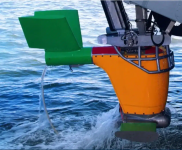
LFVDS by CFF Fluid Control Ltd. and Atlas Elektronik. CFF Fluid Control Ltd. image.
The ASW-SWC vessels are equipped with sophisticated sonar equipment, including an ABHAY hull-mounted sonar (HMS), an underwater acoustic communication system (UWACS) that enables the communication between submerged and surface platforms and a towed low-frequency variable-depth sonar (LFVDS) procured from a partnership firm formed by Indian CFF Fluid Control Ltd. and German Atlas Elektronik, a division of Thyssenkrupp Marine Systems (TKMS), allowing the ships to detect enemy submarines at greater depths and distances, even in challenging underwater environments.
ABHAY is a compact active sonar system with enhanced passive capabilities. It employs advanced adaptive signal and information processing techniques for detection, tracking and classification of targets. The suite consists of a transducer array, data acquisition system, power amplifier and the dual multi-function console (DMFC). It is designed and developed by Naval Physical and Oceanographic Laboratory (NPOL), Defence Research and Development Organization of MoD and manufactured by Bharat Electronics Limited (BEL).
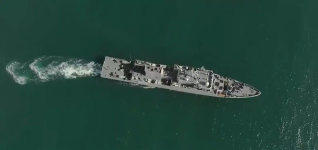
Overhead view of INS Arnala during sea trials, showcasing its distinctive equipment configuration. Image courtesy of the Indian Navy.
The ships are also equipped with two navigation radars and an electronic warfare (EW) suite that includes R-ESM system and C-ESM/COMINT system. All sensors and weapon systems are integrated into the combat management system (CMS), The ships also feature an integrated bridge system and an integrated ASW complex (IAC) developed by BEL in association with DRDO, that computes fire control solutions and facilitates firing of ASW weapons such as torpedoes and rockets.
India Commissions Its First ASW-SWC Corvette - Naval News
Electronic Equipment

LFVDS by CFF Fluid Control Ltd. and Atlas Elektronik. CFF Fluid Control Ltd. image.
The ASW-SWC vessels are equipped with sophisticated sonar equipment, including an ABHAY hull-mounted sonar (HMS), an underwater acoustic communication system (UWACS) that enables the communication between submerged and surface platforms and a towed low-frequency variable-depth sonar (LFVDS) procured from a partnership firm formed by Indian CFF Fluid Control Ltd. and German Atlas Elektronik, a division of Thyssenkrupp Marine Systems (TKMS), allowing the ships to detect enemy submarines at greater depths and distances, even in challenging underwater environments.
ABHAY is a compact active sonar system with enhanced passive capabilities. It employs advanced adaptive signal and information processing techniques for detection, tracking and classification of targets. The suite consists of a transducer array, data acquisition system, power amplifier and the dual multi-function console (DMFC). It is designed and developed by Naval Physical and Oceanographic Laboratory (NPOL), Defence Research and Development Organization of MoD and manufactured by Bharat Electronics Limited (BEL).

Overhead view of INS Arnala during sea trials, showcasing its distinctive equipment configuration. Image courtesy of the Indian Navy.
The ships are also equipped with two navigation radars and an electronic warfare (EW) suite that includes R-ESM system and C-ESM/COMINT system. All sensors and weapon systems are integrated into the combat management system (CMS), The ships also feature an integrated bridge system and an integrated ASW complex (IAC) developed by BEL in association with DRDO, that computes fire control solutions and facilitates firing of ASW weapons such as torpedoes and rockets.
India Commissions Its First ASW-SWC Corvette - Naval News
At 78m and 1,500 t, she is almost as large as the Chinese Type 056 corvette. Probably not what the IN had in mind. But no reason not to explore a diesel-powered variant with a helipad and full-spec weapons fit for open-ocean operations. Could be a cheap export option for countries like Mauritius and perhaps even Vietnam.


